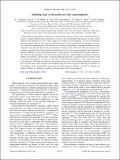| dc.contributor.author | Minnich, Austin Jerome | |
| dc.contributor.author | Lee, H. | |
| dc.contributor.author | Wang, X. W. | |
| dc.contributor.author | Joshi, G. | |
| dc.contributor.author | Dresselhaus, Mildred | |
| dc.contributor.author | Ren, Z. F. | |
| dc.contributor.author | Chen, Gang | |
| dc.contributor.author | Vashaee, D. | |
| dc.date.accessioned | 2010-03-10T15:57:06Z | |
| dc.date.available | 2010-03-10T15:57:06Z | |
| dc.date.issued | 2009-10 | |
| dc.date.submitted | 2009-08 | |
| dc.identifier.issn | 1550-235X | |
| dc.identifier.issn | 1098-0121 | |
| dc.identifier.uri | http://hdl.handle.net/1721.1/52461 | |
| dc.description.abstract | Nanocomposite thermoelectric materials have attracted much attention recently due to experimental demonstrations of improved thermoelectric properties over those of the corresponding bulk material. In order to better understand the reported data and to gain insight into transport in nanocomposites, we use the Boltzmann transport equation under the relaxation-time approximation to calculate the thermoelectric properties of n-type and p-type SiGe nanocomposites. We account for the strong grain-boundary scattering mechanism in nanocomposites using phonon and electron grain-boundary scattering models. The results from this analysis are in excellent agreement with recently reported measurements for the n-type nanocomposite but the experimental Seebeck coefficient for the p-type nanocomposite is approximately 25% higher than the model’s prediction. The reason for this discrepancy is not clear at the present time and warrants further investigation. Using new mobility measurements and the model, we find that dopant precipitation is an important process in both n-type and p-type nanocomposites, in contrast to bulk SiGe, where dopant precipitation is most significant only in n-type materials. The model also shows that the potential barrier at the grain boundary required to explain the data is several times larger than the value estimated using the Poisson equation, indicating the presence of crystal defects in the material. This suggests that an improvement in mobility is possible by reducing the number of defects or reducing the number of trapping states at the grain boundaries. | en |
| dc.language.iso | en_US | |
| dc.publisher | American Physical Society | en |
| dc.relation.isversionof | http://dx.doi.org/10.1103/PhysRevB.80.155327 | en |
| dc.rights | Article is made available in accordance with the publisher's policy and may be subject to US copyright law. Please refer to the publisher's site for terms of use. | en |
| dc.source | APS | en |
| dc.title | Modeling study of thermoelectric SiGe nanocomposites | en |
| dc.type | Article | en |
| dc.identifier.citation | Minnich, A. J. et al. “Modeling study of thermoelectric SiGe nanocomposites.” Physical Review B 80.15 (2009): 155327. © 2009 The American Physical Society | en |
| dc.contributor.department | Massachusetts Institute of Technology. Department of Electrical Engineering and Computer Science | en_US |
| dc.contributor.department | Massachusetts Institute of Technology. Department of Mechanical Engineering | en_US |
| dc.contributor.department | Massachusetts Institute of Technology. Department of Physics | en_US |
| dc.contributor.approver | Dresselhaus, Mildred | |
| dc.contributor.mitauthor | Minnich, Austin Jerome | |
| dc.contributor.mitauthor | Lee, H. | |
| dc.contributor.mitauthor | Dresselhaus, Mildred | |
| dc.contributor.mitauthor | Chen, Gang | |
| dc.relation.journal | Physical Review B | en |
| dc.eprint.version | Final published version | en |
| dc.type.uri | http://purl.org/eprint/type/JournalArticle | en |
| eprint.status | http://purl.org/eprint/status/PeerReviewed | en |
| dspace.orderedauthors | Minnich, A.; Lee, H.; Wang, X.; Joshi, G.; Dresselhaus, M.; Ren, Z.; Chen, G.; Vashaee, D. | en |
| dc.identifier.orcid | https://orcid.org/0000-0001-8492-2261 | |
| dc.identifier.orcid | https://orcid.org/0000-0002-3968-8530 | |
| mit.license | PUBLISHER_POLICY | en |
| mit.metadata.status | Complete | |
